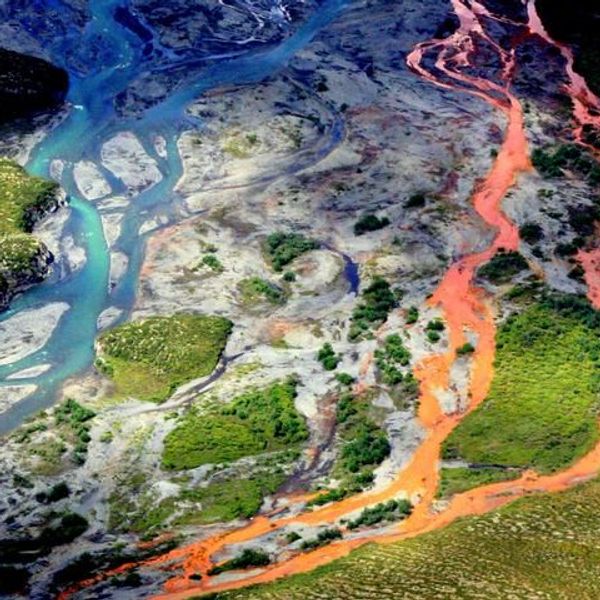What 35,000 Walruses Forced to the Beach Tell Us About Global Warming
As sea ice recedes amid warming oceans, Pacific walruses crowd onto beaches to rest and forage for food
Federal biologists have discovered an unusual phenomenon on a beach in northwest Alaska: a massive gathering of walruses--35,000 of them--crowded onto a small strip of shore.
This swarm, which was sighted in a National Oceanic and Atmospheric Administration aerial survey on Saturday, is a direct result of a warming climate and declining sea ice, say scientists.
Pacific walruses, who live in the Bering Sea during winter, require floating sea ice to meet their survival needs, using them for rest in between journeys to forage for food, such as clam, snails, and worms, as well as for giving birth and caring for their young. But as the oceans warm, this sea ice is receding, especially near coastal areas, forcing these walruses to take to the beach for resting and foraging, according to an explanation from the NOAA.
"The walruses are telling us what the polar bears have told us and what many indigenous people have told us in the high Arctic.""The walruses are telling us what the polar bears have told us and what many indigenous people have told us in the high Arctic, and that is that the Arctic environment is changing extremely rapidly and it is time for the rest of the world to take notice and also to take action to address the root causes of climate change," said Margaret Williams, managing director of the group's Arctic program, in a statement.
The burly mammals were found just north of Point Lay, an Inupiat Eskimo village. According to Andrea Medeiros, spokeswoman for the U.S. Fish and Wildlife Service, the walruses were first sighted in mid-September, and dozens of carcasses have been identified, likely due to stampede.
Chadwick Jay, research ecologist and leader of the U.S. Geological Survey's Pacific walrus research program, said that similar large aggregations of walruses have been seen in and near the area in recent years. The WWF tracked 20,000 walruses on the shore at Ryrkaipiy on the Chukchi Sea in Russia in 2009.
Two years ago, Nick Sundt of WWF warned, "As in past years, it now appears likely that we again will see large numbers of walruses forced onto Alaska's beaches. These iconic images will starkly illustrate the massive disruption that is occurring in the Arctic as the region rapidly warms."
An Urgent Message From Our Co-Founder
Dear Common Dreams reader, The U.S. is on a fast track to authoritarianism like nothing I've ever seen. Meanwhile, corporate news outlets are utterly capitulating to Trump, twisting their coverage to avoid drawing his ire while lining up to stuff cash in his pockets. That's why I believe that Common Dreams is doing the best and most consequential reporting that we've ever done. Our small but mighty team is a progressive reporting powerhouse, covering the news every day that the corporate media never will. Our mission has always been simple: To inform. To inspire. And to ignite change for the common good. Now here's the key piece that I want all our readers to understand: None of this would be possible without your financial support. That's not just some fundraising cliche. It's the absolute and literal truth. We don't accept corporate advertising and never will. We don't have a paywall because we don't think people should be blocked from critical news based on their ability to pay. Everything we do is funded by the donations of readers like you. Will you donate now to help power the nonprofit, independent reporting of Common Dreams? Thank you for being a vital member of our community. Together, we can keep independent journalism alive when it’s needed most. - Craig Brown, Co-founder |
Federal biologists have discovered an unusual phenomenon on a beach in northwest Alaska: a massive gathering of walruses--35,000 of them--crowded onto a small strip of shore.
This swarm, which was sighted in a National Oceanic and Atmospheric Administration aerial survey on Saturday, is a direct result of a warming climate and declining sea ice, say scientists.
Pacific walruses, who live in the Bering Sea during winter, require floating sea ice to meet their survival needs, using them for rest in between journeys to forage for food, such as clam, snails, and worms, as well as for giving birth and caring for their young. But as the oceans warm, this sea ice is receding, especially near coastal areas, forcing these walruses to take to the beach for resting and foraging, according to an explanation from the NOAA.
"The walruses are telling us what the polar bears have told us and what many indigenous people have told us in the high Arctic.""The walruses are telling us what the polar bears have told us and what many indigenous people have told us in the high Arctic, and that is that the Arctic environment is changing extremely rapidly and it is time for the rest of the world to take notice and also to take action to address the root causes of climate change," said Margaret Williams, managing director of the group's Arctic program, in a statement.
The burly mammals were found just north of Point Lay, an Inupiat Eskimo village. According to Andrea Medeiros, spokeswoman for the U.S. Fish and Wildlife Service, the walruses were first sighted in mid-September, and dozens of carcasses have been identified, likely due to stampede.
Chadwick Jay, research ecologist and leader of the U.S. Geological Survey's Pacific walrus research program, said that similar large aggregations of walruses have been seen in and near the area in recent years. The WWF tracked 20,000 walruses on the shore at Ryrkaipiy on the Chukchi Sea in Russia in 2009.
Two years ago, Nick Sundt of WWF warned, "As in past years, it now appears likely that we again will see large numbers of walruses forced onto Alaska's beaches. These iconic images will starkly illustrate the massive disruption that is occurring in the Arctic as the region rapidly warms."
Federal biologists have discovered an unusual phenomenon on a beach in northwest Alaska: a massive gathering of walruses--35,000 of them--crowded onto a small strip of shore.
This swarm, which was sighted in a National Oceanic and Atmospheric Administration aerial survey on Saturday, is a direct result of a warming climate and declining sea ice, say scientists.
Pacific walruses, who live in the Bering Sea during winter, require floating sea ice to meet their survival needs, using them for rest in between journeys to forage for food, such as clam, snails, and worms, as well as for giving birth and caring for their young. But as the oceans warm, this sea ice is receding, especially near coastal areas, forcing these walruses to take to the beach for resting and foraging, according to an explanation from the NOAA.
"The walruses are telling us what the polar bears have told us and what many indigenous people have told us in the high Arctic.""The walruses are telling us what the polar bears have told us and what many indigenous people have told us in the high Arctic, and that is that the Arctic environment is changing extremely rapidly and it is time for the rest of the world to take notice and also to take action to address the root causes of climate change," said Margaret Williams, managing director of the group's Arctic program, in a statement.
The burly mammals were found just north of Point Lay, an Inupiat Eskimo village. According to Andrea Medeiros, spokeswoman for the U.S. Fish and Wildlife Service, the walruses were first sighted in mid-September, and dozens of carcasses have been identified, likely due to stampede.
Chadwick Jay, research ecologist and leader of the U.S. Geological Survey's Pacific walrus research program, said that similar large aggregations of walruses have been seen in and near the area in recent years. The WWF tracked 20,000 walruses on the shore at Ryrkaipiy on the Chukchi Sea in Russia in 2009.
Two years ago, Nick Sundt of WWF warned, "As in past years, it now appears likely that we again will see large numbers of walruses forced onto Alaska's beaches. These iconic images will starkly illustrate the massive disruption that is occurring in the Arctic as the region rapidly warms."

